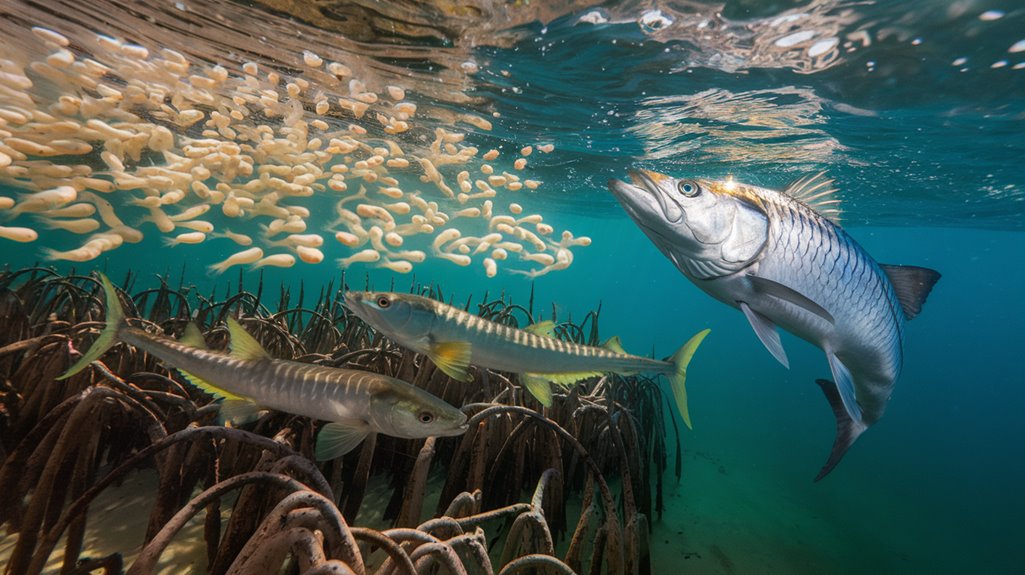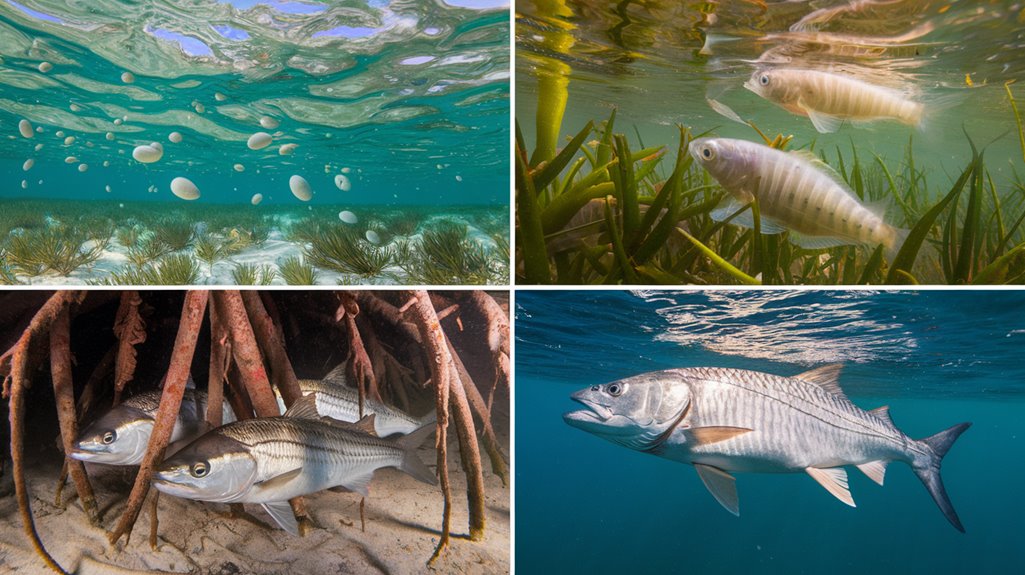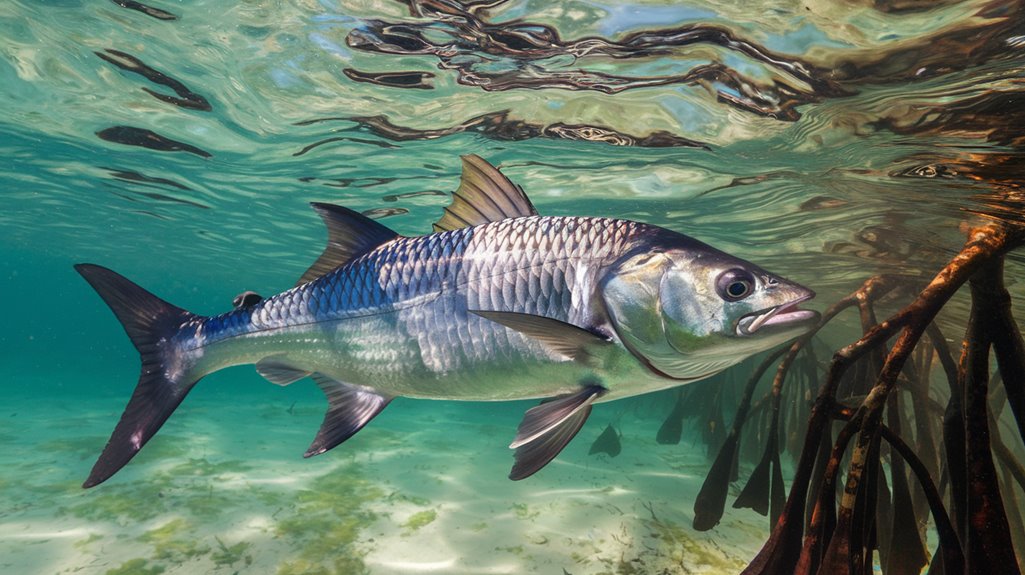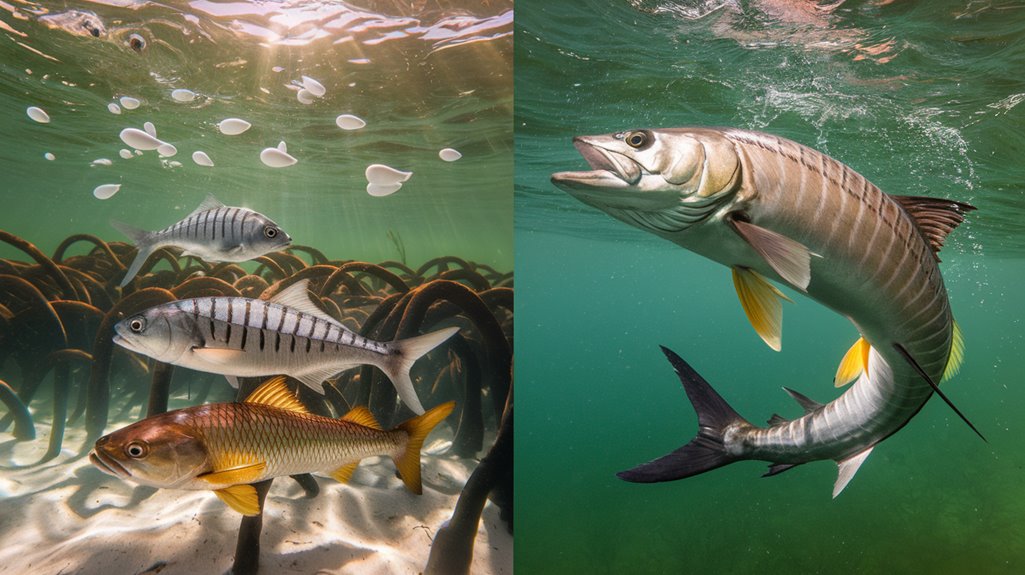You’ll find the tarpon’s transformation from microscopic egg to massive gamefish both scientifically fascinating and biologically complex. At spawning, a female releases 12-15 million eggs, each measuring 0.7-1.2mm in diameter, into offshore waters 20-30 meters deep. These eggs develop into distinctive leptocephalus larvae within 20-30 hours, setting in motion one of nature’s most remarkable metamorphoses, which culminates in a 2-meter-long, 150kg apex predator.
- Key Takeaways
- The Spawning Journey: Offshore Adventures
- Early Life as Leptocephalus Larvae
- Navigating to Protected Waters
- Growth in Estuarine Nurseries
- Sub-Adult Development and Adaptations
- Reaching Sexual Maturity
- Migration Patterns of Adult Tarpon
- Habitat Requirements Through Life Stages
- Conservation and the Future of Silver Kings
- Frequently Asked Questions
- Conclusion
Key Takeaways
- Adult tarpon spawn offshore, releasing up to 12 million eggs during nighttime lunar cycles from April to June.
- Fertilized eggs develop into transparent, eel-like leptocephalus larvae that drift with ocean currents for about one month.
- Larvae enter estuaries at night, growing to 3-4 inches before transforming into juvenile tarpon in seagrass beds.
- Juveniles develop in sheltered backwaters, using their specialized swim bladder to survive in low-oxygen environments.
- Adult tarpon migrate up to 1,200 miles along coastlines, reaching maturity between 6-12 years depending on gender.
The Spawning Journey: Offshore Adventures

When late spring arrives, adult tarpon commence on an extraordinary spawning migration that takes them over 100 miles offshore into deeper waters. You’ll find large schools synchronizing their reproductive activities with lunar cycles, particularly during full and new moons. During the spawning season, females release up to 12 million eggs while performing profound dives, where they’re fertilized through broadcast spawning methods.
The offshore spawning grounds serve as essential sites for reproduction, with nighttime spawning reducing predation risks on eggs. This strategy enhances survival rates as eggs develop into the larval stage. As the fertilized eggs transform into leptocephalus larvae, they’ll drift with ocean currents for approximately one month before moving toward estuaries. This extensive migration pattern guarantees genetic diversity and maintains healthy population dynamics throughout their range.
Early Life as Leptocephalus Larvae
The newly hatched tarpon emerges as a quarter-inch leptocephalus larva, transparent and eel-like in appearance. During its one-month larval phase, you’ll find these delicate creatures drifting with ocean currents, strategically maneuvering toward protective habitats. They’ve adapted to enter estuaries under the cover of darkness, minimizing predation risks through reduced visibility.
As they progress through early development, leptocephalus larvae grow to 3-4 inches before evolving into juvenile forms. You’ll observe them utilizing seagrass beds and oyster reefs as vital staging areas, where they find essential nutrition and shelter. These diverse ecosystems serve as nursery grounds, supporting the larvae’s metamorphosis while offering protection from predators. This transformative period marks a significant phase in their development from transparent larvae to recognizable juvenile tarpon.
Navigating to Protected Waters

Young tarpon actively seek out sheltered estuaries and backbay creeks during their critical change from larvae to juveniles. You’ll find these developing fish maneuvering through mangrove-lined waterways, where they’re adapting to low oxygen conditions by utilizing their newly formed swim bladder to gulp air from the surface. This physiological adaptation proves essential for their survival in these oxygen-depleted environments.
These sheltered estuaries serve as critical nurseries, providing juvenile tarpon with both protection from predators and abundant food resources. As you examine their habitat requirements, you’ll notice the significance of protecting estuarine environments for ensuring their survival and growth. Current research efforts focus on identifying and preserving these essential backwater areas, which support the successful shift of juvenile tarpon into their adult phase.
Growth in Estuarine Nurseries
Safe within estuarine nurseries, juvenile tarpon undergo significant physiological development while maximizing their growth potential. You’ll find these young fish expertly maneuvering through seagrass beds and oyster reefs, utilizing their specialized swim bladder to gulp air when oxygen levels drop in hypoxic waters. During their two-year juvenile stage, they’re continuously adapting to various microhabitats within the estuary system.
- Watch in amazement as they shift from helpless leptocephalus larvae to powerful swimmers
- Marvel at their remarkable ability to thrive in low-oxygen conditions where other fish can’t survive
- Witness their strategic use of mangrove sanctuaries for protection against predators
- Observe their precise movements through complex habitat structures
These critical habitats serve as essential training grounds, preparing juvenile tarpon for their eventual migration to offshore waters.
Sub-Adult Development and Adaptations

Between ages two and five, sub-adult tarpon enter an essential developmental phase marked by increased predatory capabilities and expanded habitat exploration. You’ll notice their adaptive behaviors intensifying as they master survival skills in oxygen-poor waters using their specialized swim bladder for aerial respiration.
| Adaptation | Function | Habitat Impact |
|---|---|---|
| Swim Bladder | Air Breathing | Oxygen-poor Waters |
| Diet Expansion | Energy Acquisition | Predatory Range |
| Habitat Selection | Protection | Backwater Areas |
Their diet now encompasses a diverse range of prey, including crabs, shrimp, and various fish species. While they’re developing increased mobility and hunting prowess, you’ll find them primarily in protective backwater areas where they can refine their predatory capabilities while minimizing exposure to larger predators. This stage represents an essential shift period where they’re building the strength and skills needed for adult survival.
Reaching Sexual Maturity
You’ll observe distinct sexual dimorphism in tarpon maturation, where females typically achieve reproductive capacity at 10-12 years and grow to 4.5 feet, while males mature earlier at 6-8 years and reach 4 feet. This differential growth pattern correlates with reproductive capacity, as mature females can generate up to 12 million eggs per spawning season, requiring greater body mass and energy reserves. Geographic variations greatly influence maturation rates, with Florida specimens reaching sexual maturity approximately two years earlier than their Costa Rican counterparts, demonstrating environmental factors’ impact on reproductive development.
Growth Rate Patterns
Tarpon exhibit remarkable growth patterns on their journey to sexual maturity, with females requiring 10-12 years to reach reproductive capability. During this developmental phase, growth rates accelerate dramatically, with specimens achieving approximately 100 pounds between ages 13-16. Juvenile tarpon initially develop in protected estuarine environments before shifting to their adult habitats within marine ecosystems.
- You’ll observe rapid early-stage development in sheltered waters
- You’ll notice sexual maturity emerging at 4 feet in length
- You’ll witness females producing up to 12 million eggs per spawning season
- You’ll see growth continuing throughout their 80+ year lifespan
This sustained growth pattern enables tarpon to maintain their position as apex predators while ensuring population stability through extensive reproductive output during spawning cycles.
Size and Sex Differences
A significant sexual dimorphism exists between male and female tarpon, particularly as they approach reproductive maturity. You’ll observe that female tarpon reach sexual maturity later than males, taking 10-12 years in Florida and Costa Rica waters, while males mature between ages 7-9. Size differences become pronounced at maturity, with females measuring approximately 4.5 feet and males reaching 4 feet in length.
The weight disparity is even more striking. Adult females can grow to an impressive 300 pounds, triple the typical 100-pound mature male weight. Female tarpon’s reproductive capacity is remarkable, with individuals producing up to 12 million eggs per spawning season. These distinct size differences and reproductive characteristics underscore why protecting diverse habitats is essential for both juvenile development and adult spawning success.
Environmental Impact Factors
Understanding how environmental factors influence tarpon maturation reveals complex interactions between habitat conditions and reproductive development. You’ll find that water temperatures and estuarine habitats directly affect spawning success, with ideal conditions occurring from April through July. During this period, mature females release up to 12 million eggs, demonstrating the critical timing of environmental variables.
- Your local tarpon populations face increasing habitat loss, threatening their survival
- You’re witnessing juvenile tarpon struggle in degraded estuarine environments
- You’ll observe delayed maturation when water temperatures fluctuate abnormally
- Your coastal ecosystem’s health directly impacts tarpon spawn rates
Environmental conditions regulate sexual maturity timing, with females requiring 10-12 years to mature in varying regions. The correlation between habitat quality and reproductive success emphasizes the necessity of preserving essential spawning grounds for sustained population growth.
Migration Patterns of Adult Tarpon
During peak reproductive seasons from April to June, mature tarpon commence extensive coastal migrations that can span up to 1,200 miles along the Gulf of Mexico and Atlantic seaboard. You’ll observe these adult tarpon forming massive schools, often containing hundreds of individuals, as they navigate toward their spawning grounds. Their migration patterns correlate strongly with lunar phases, particularly during full and new moons, which trigger their offshore movements.
When spawning conditions are ideal, female tarpon release up to 12 million eggs during nocturnal offshore events. This nighttime reproduction strategy greatly reduces egg predation rates. These synchronized migrations demonstrate the species’ remarkable ability to coordinate large-scale movements through both the Gulf of Mexico and Atlantic Ocean waters, ensuring successful reproduction and population sustainability.
Habitat Requirements Through Life Stages
Each life stage of tarpon requires distinct habitat conditions for ideal survival and development. You’ll find larval fish entering estuaries nocturnally during their one-month stage, seeking protection in seagrass beds and oyster reefs. Juvenile tarpon adapt to backbay environments with low dissolved oxygen, using their swim bladder for aerial respiration. Sub-adults expand their habitat range while still requiring sheltered areas until reaching maturity at 6-12 years.
- Primary larval habitat zones require protection from predators via seagrass coverage
- Juvenile sanctuaries must maintain dissolved oxygen levels below 2 mg/L
- Sub-adult change zones need interconnected waterways spanning 5-10 miles
- Adult coastal ranges extend up to 1,200 miles in waters above 72°F
Conservation of these critical habitats, particularly mangroves and seagrass beds, guarantees survival across all life stages.
Conservation and the Future of Silver Kings
As coastal development and climate change intensify, tarpon populations face mounting pressure from habitat degradation and shifting migration patterns. You’ll find conservation efforts focused on protecting essential ecosystems, including mangroves and seagrass beds, which serve as critical nursery grounds for these Silver Kings.
Florida’s prohibition on commercial tarpon sales demonstrates the shift toward sustainable fishing practices. Research shows that proper catch and release techniques greatly improve survival rates, while habitat restoration projects help maintain the species’ complex migratory patterns. The Bonefish and Tarpon Trust’s data-driven approach emphasizes the need for interstate coordination to protect these fish throughout their range. To secure tarpon’s future, you’ll need to support thorough management strategies that address both local and regional challenges affecting these remarkable gamefish.
Frequently Asked Questions
How Old Is a 100 Pound Tarpon?
You’ll find that a 100-pound tarpon typically reaches this mass between 13-16 years of age, though environmental conditions and regional factors can influence their specific growth trajectory.
What Is the Lifespan of a Tarpon?
You’ll find that tarpon can live up to 80+ years in tropical waters, with verified specimens reaching 63 years in captivity. Their longevity depends on environmental conditions and habitat quality.
What Does a Baby Tarpon Look Like?
You’ll find baby tarpon as leptocephalus larvae measuring 0.25 inches at hatching, appearing nearly transparent with an eel-like morphology. They’ll grow to 3-4 inches during their month-long larval stage.
What Is the Tarpon Migratory Pattern?
You’ll observe tarpon migrating up to 1,200 miles during spring spawning, following lunar cycles. They travel northward from Central America along coastal waters, congregating offshore for nocturnal reproduction between April-June.
Conclusion
You’ll observe that tarpon (Megalops atlanticus) complete their life cycle through precisely defined stages, from planktonic leptocephalus larvae measuring 0.5-0.7mm to sexually mature adults reaching 2m in length. Their physiological adaptations, including the physostomous swim bladder’s optimization for aerial respiration, enable survival across diverse habitats. Current data indicates a 20-30 year lifespan, with sexual maturity occurring at 7-13 years when specimens reach 1.2-1.5m.

